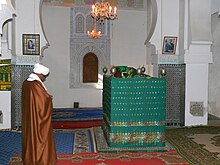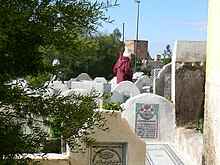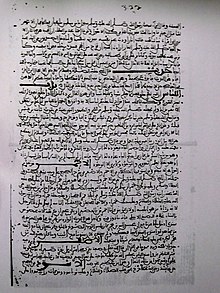Ibn al-ʿArabī al-Maʿāfirī
Ibn al-ʿArabī al-Maʿāfirī ( Arabic ابن العربي المعافري, DMG Ibn al-ʿArabī al-Maʿāfirī ), also known as Abū Bakr ibn al-ʿArabī (أبو بكر بن العربي / Abū Bakr b. al-ʿArabī ), Nasab محمد بن عبد الله بن محمد / Muḥammad b. ʿAbdallāh b. Muḥammad , Nisba الإشبيلي / al-Išbīlī (* 1076 in Seville , † 1148 in Fez ) was a Maliki jurist and Islamic theologian of Andalusian origin .
Life
A detailed biography of him was written by his contemporary ūIyād ibn Mūsā , the famous Maliki scholar and Qādī of Sabta (d. 1149). He initially studied in his hometown of Seville (Arabic: Ischbīlīya /إشبيلية / Išbīlīya ), then with well-known scholars in Córdoba . With his father he traveled to the Orient and studied in Syria , Baghdad , where he attended the lectures of al-Ghazālī , and also in Mecca and Egypt .
After the death of his father in Alexandria in 1099–1100 - according to adh-Dhahabī in his scholarly biography in Jerusalem - he returned to his native Seville, where he held the office of chief Qādī for a time and had a large group of students, including Ibn Bashkuwāl belonged. The students of Fiqh finished their legal training by reading one of the most famous collections of legal cases of Andalusia, al-Aḥkām al-kubrā by ʿĪsā ibn Sahl (d. 1093), the Qādī of Córdoba. In his office as judge, Ibn al-ʿArabi was very much feared because he took rigorous action against wrongdoers. As he himself reports in his work al-ʿAwāṣim min al-qawāṣim , one day, as a result of his harsh judgments, various lawbreakers banded together and besieged him in his house. According to a tradition that al-Maqqarī cites in his historical work Nafḥ aṭ-ṭīb , it was Ibn al-ʿArabī's rigor that ultimately led to his dismissal from the judiciary. He was released after having pierced the jaws of a wind instrument player. After the conquest of Seville by the Almohads , Ibn al-abArabī was exiled to Marrakech , where he spent a year in prison. He died on his way from Marrakech to Fès in September 1148.
He was buried outside the city wall on the Bāb al-Mahrūq of Fez. His grave is still a popular place of pilgrimage today and the entire cemetery is a coveted burial site today.
From his extensive study trips Ibn al-ʿArabī brought around 50 works in the field of Hadith, Fiqh and Islamic historiography to Seville and taught them in his hometown. His contemporaries valued him as a credible scholar; only Ibn Hajar al-ʿAsqalānī referred to him as a “weak” (daʿīf) traditionarian. He was wealthy and had the city walls of Seville, so adh-Dhahabī, rebuilt at his own expense.
Works
Ibn al-ʿArabī wrote several works in the field of Fiqh , Koran exegesis , Hadith , theology and mysticism , which are only partially preserved today. In the Andalusian scholars' biographies, 88 work titles are listed. His writings are basic sources of the Maliki school of law. He quotes some of them in his commentary on the Muwattaʾ .
- Ahkām al-Quran أحكام القرآن / Aḥkām al-Qurʾān / 'The Laws of the Koran' is not an exegesis of the Koran in the classical sense, but the summary and explanation of those verses of the Koran that have general validity in Malikite Islamic jurisprudence. At the request of Mulai Abd al-Hafiz , the Sultan of the Alawids in Morocco, the work was first published in Cairo in 1912 thanks to his funding. Another, but only partially improved, edition followed in 1958 in Cairo and 1972 in Beirut. According to previously unknown manuscripts, the complete introduction to the work was only published in 2011.
- An-Nāsich wal-mansūch الناسخ والمنسوخ / an-nāsiḫ wa-ʾl-mansūḫ / 'The abrogate and the abrogate' deals with those verses of the Koran which, in the opinion of the traditionalists and Koran exegetes, are suspended or restricted in their legal or theological validity by other verses of the Koran . The work did not appear in print until 1988.
- Qānūn at-taʾwīl fī-t-tafsīr قانون التأويل في التفسير / 'The Law of Interpretation in Exegesis of the Koran' is preserved in manuscripts in Cairo .
- Al-Masālik fī sharh Muwattaʾ Mālik المسالك في شرح موطأ مالك / al-masālik fī šarḥ Muwaṭṭaʾ Mālik / 'Methods of explaining the Muwatta' of Malik '. This commentary on the Muwatta 'by Mālik ibn Anas is preserved in two volumes in a Moroccan manuscript library.
- Al-Qabas fī Sharh Muwattaʾ Ibn Anas القبس في شرح موطأ ابن أنس / Al-Qabas fī Sharḥ Muwatta Ibn Anas / processing explaining the Muwatta of (Mālik) ibn Anas' is also a comment to Muwatta, in which the author in the base handed Hadithe explained content and often other on the teachings Madhhabs to with whom he had contact on his study trip. The work has been in print since 1998.
literature
- Carl Brockelmann: History of Arabic Literature. Second edition adapted to the supplement volumes. Brill, Leiden 1943. Vol. 1, p. 525; Supplement volume 1, Brill, Leiden 1937. pp. 632-633; Pp. 732-733.
- ʿAbd al-Kabīr al-ʿAlawī al-Madġirī: An-Nāsiḫ wa-l-mansūḫ fī l-Qurʾān al-karīm . Part 1 ad-Dirāsa . Rabat 1988.
- J. Robson: Art. "Ibn al-ʿArabī" in The Encyclopaedia of Islam. New Edition Vol. III, p. 707.
- Fuat Sezgin: History of Arabic Literature . Brill, Leiden 1967. Vol. 1, pp. 461-462
Individual evidence
- ^ The Encyclopaedia of Islam . New Edition. Brill, suffering. Vol. 4, p. 289
- ↑ Vol. 20, p. 199
- ↑ Christian Müller: Court practice in the city-state of Córdoba. On the law of society in a Malikite-Islamic legal tradition of the 5th / 11th Century. Brill, Leiden 1999. p. 17
- ↑ Cf. al-Madġirī 25.
- ↑ See the list in: An-Nāsiḫ wa-ʾl-mansūḫ fī ʾl-Qurʾān al-karīm. Ed. ʿAbd al-Kabīr al-ʿAlawī al-Madġirī. Vol. 1 (introduction) Rabat 1988, pp. 89-109
- ^ The Encyclopaedia of Islam . New Edition. Vol. 3, p. 707
- ↑ Vol. 20, p. 201
- ↑ See the list of his writings: An-Nāsiḫ wa-ʾl-mansūḫ fī ʾl-Qurʾān al-karīm. Ed. ʿAbd al-Kabīr al-ʿAlawī al-Madġirī. Vol. 1 (introduction) Rabat 1988, pp. 115-129
- ↑ al-Qabas fī šarḥ Muwaṭṭaʾ Ibn Anas . Vol. 1, pp. 25-30 (introduction by the editors)
- ↑ ʿAbd ar-Razzāq Harmās: Muqaddima Aḥkām al-Qurʾān li-Ibn al-ʿArabī allatī fuqida sāʾiru-hā min ṭabʿāt al-kitāb . Agadir 2011
- ↑ An-Nāsiḫ wa-ʾl-mansūḫ fī ʾl-Qurʾān al-karīm . Ed. ʿAbd al-Kabīr al-ʿAlawī al-Madġirī. 2 volumes. Rabat 1988
- ↑ Carl Brockelmann, Vol. 1, p. 525
- ↑ See: An-Nāsiḫ wa-ʾl-mansūḫ fī ʾl-Qurʾān al-karīm. Ed. ʿAbd al-Kabīr al-ʿAlawī al-Madġarī. Vol. 1 (introduction) Rabat 1988, p. 126; C. Brockelmann, Supplement 1, p. 298; P. 733; Fuat Sezgin (1967), p. 461 (No. 10) with further details. Printed in eight volumes in the edition of Muḥammad ibn al-Ḥusain as-Sulaimānī and ʿĀʾiša bint al-Ḥusain as-Sulaimānī. Dār al-Gharb al-Islāmī. Beirut 2007 (With a foreword by Yūsuf al-Qaraḍāwī )
- ↑ Fuat Sezgin (1967), p. 462 (No. 11). Printed in 4 volumes in Beirut. Dar al-kutub al-'ilmiya. 1st edition. 1998
| personal data | |
|---|---|
| SURNAME | Ibn al-ʿArabī al-Maʿāfirī |
| ALTERNATIVE NAMES | Ibn-al-ʿArabī, Abū-Bakr Muḥammad Ibn-ʿAbdallāh |
| BRIEF DESCRIPTION | Islamic legal scholar and theologian |
| DATE OF BIRTH | 1076 |
| PLACE OF BIRTH | Seville |
| DATE OF DEATH | 1148 |
| Place of death | Fez |



